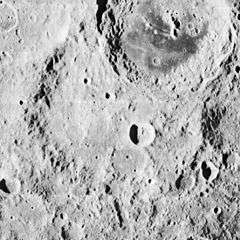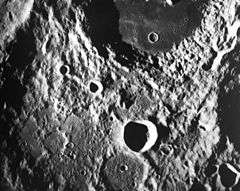Vertregt (crater)
Vertregt is the ancient remnant of a large lunar impact crater. It is located on the far side of the Moon, to the north of the unusual walled plain Van de Graaff. The prominent crater Aitken lies across the northeast rim of Vertregt, and Zwicky is attached to the northwestern rim.
 Lunar Orbiter 2 image | |
| Coordinates | 19.8°S 171.1°E |
|---|---|
| Diameter | 187 km |
| Depth | Unknown |
| Colongitude | 189° at sunrise |
| Eponym | Marinus Vertregt |

Vertregt has been heavily eroded and reshaped by subsequent events, leaving only a few segments of the outer rim still visible. The northwestern section of the rim is the most intact portion, although even this arcing ridge is marked by small craterlets.
The interior consists of rugged ridges and smaller impacts, most prominently the crater pair of Vertregt L and Vertregt K in the southeast. There is a wide rift leading from the southern end of the crater floor towards Van de Graaff.
Satellite craters
By convention these features are identified on lunar maps by placing the letter on the side of the crater midpoint that is closest to Vertregt.
| Vertregt | Latitude | Longitude | Diameter |
|---|---|---|---|
| J | 21.5° S | 174.3° E | 17 km |
| K | 20.1° S | 172.0° E | 27 km |
| L | 21.1° S | 171.5° E | 38 km |
| P | 23.6° S | 170.0° E | 24 km |
| R | 21.8° S | 167.1° E | 25 km |
References
- Andersson, L. E.; Whitaker, E. A. (1982). NASA Catalogue of Lunar Nomenclature. NASA RP-1097.CS1 maint: ref=harv (link)
- Blue, Jennifer (July 25, 2007). "Gazetteer of Planetary Nomenclature". USGS. Retrieved 2007-08-05.CS1 maint: ref=harv (link)
- Bussey, B.; Spudis, P. (2004). The Clementine Atlas of the Moon. New York: Cambridge University Press. ISBN 978-0-521-81528-4.CS1 maint: ref=harv (link)
- Cocks, Elijah E.; Cocks, Josiah C. (1995). Who's Who on the Moon: A Biographical Dictionary of Lunar Nomenclature. Tudor Publishers. ISBN 978-0-936389-27-1.CS1 maint: ref=harv (link)
- McDowell, Jonathan (July 15, 2007). "Lunar Nomenclature". Jonathan's Space Report. Retrieved 2007-10-24.CS1 maint: ref=harv (link)
- Menzel, D. H.; Minnaert, M.; Levin, B.; Dollfus, A.; Bell, B. (1971). "Report on Lunar Nomenclature by the Working Group of Commission 17 of the IAU". Space Science Reviews. 12 (2): 136–186. Bibcode:1971SSRv...12..136M. doi:10.1007/BF00171763.CS1 maint: ref=harv (link)
- Moore, Patrick (2001). On the Moon. Sterling Publishing Co. ISBN 978-0-304-35469-6.CS1 maint: ref=harv (link)
- Price, Fred W. (1988). The Moon Observer's Handbook. Cambridge University Press. ISBN 978-0-521-33500-3.CS1 maint: ref=harv (link)
- Rükl, Antonín (1990). Atlas of the Moon. Kalmbach Books. ISBN 978-0-913135-17-4.CS1 maint: ref=harv (link)
- Webb, Rev. T. W. (1962). Celestial Objects for Common Telescopes (6th revised ed.). Dover. ISBN 978-0-486-20917-3.CS1 maint: ref=harv (link)
- Whitaker, Ewen A. (1999). Mapping and Naming the Moon. Cambridge University Press. ISBN 978-0-521-62248-6.CS1 maint: ref=harv (link)
- Wlasuk, Peter T. (2000). Observing the Moon. Springer. ISBN 978-1-85233-193-1.CS1 maint: ref=harv (link)